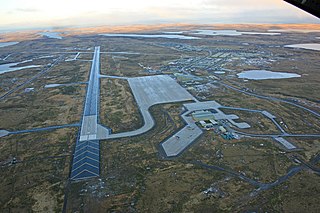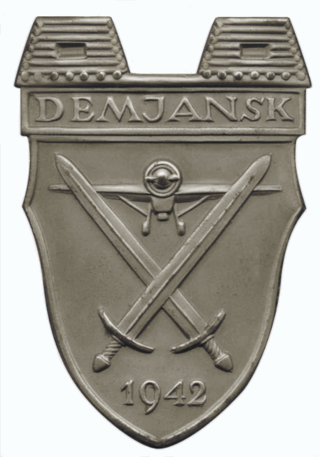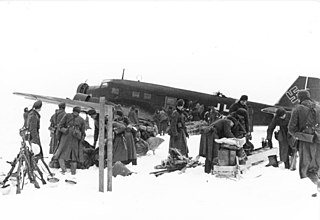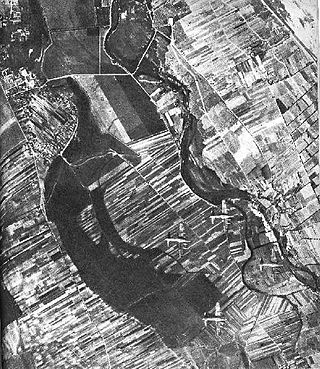The Falkland Islands currently has three primary means of transport - road, sea and air. However, in 1946, when Sir Miles Clifford arrived as governor, there were no air services, no roads outside Stanley and an indifferent sea service. Sir Miles was instrumental in starting the Falkland Islands Government Air Service in December 1948. The inaugural flight involved a mercy flight from North Arm Settlement to Stanley to bring a girl with peritonitis to life-saving medical help in Stanley. There is now an international airport, a domestic airport, a number of airstrips, a growing road network and a much-improved ferry service between the two main islands.

RAF Mount Pleasant is a Royal Air Force station in the British Overseas Territory of the Falkland Islands. The airfield goes by the motto of "Defend the right" and is part of the British Forces South Atlantic Islands (BFSAI). Home to between 1,000 and 2,000 British military personnel, it is about 33 miles (53 km) southwest of Stanley, the capital of the Falklands, on the island of East Falkland. The world's longest corridor, 2,600 feet (800 m) long, links the barracks, messes, and recreational and welfare areas of the station, and was nicknamed the "Death Star Corridor" by personnel due to its drab and foreboding ambiente, before it was re-designed, re-painted, and re-named "Millennium Corridor".

Operations Black Buck 1 to Black Buck 7 were seven extremely long-range ground attack missions conducted during the 1982 Falklands War by Royal Air Force (RAF) Vulcan bombers of the RAF Waddington Wing, comprising aircraft from Nos. 44, 50 and 101 Squadrons, against Argentine positions in the Falkland Islands. Five of the missions completed attacks. The objective of the missions was to attack Port Stanley Airport and its associated defences. The raids, at almost 6,600 nautical miles and 16 hours for the round trip, were the longest-ranged bombing raids in history at that time.

Atlantic Conveyor was a British merchant navy ship, registered in Liverpool, that was requisitioned during the Falklands War.

The Siege of Malta in World War II was a military campaign in the Mediterranean theatre. From June 1940 to November 1942, the fight for the control of the strategically important island of the British Crown Colony of Malta pitted the air and naval forces of Fascist Italy and Nazi Germany against the Royal Air Force (RAF) and the Royal Navy.

RAF Ascension Island, also known as Wideawake Airfield or Ascension Island Auxiliary Field, is a military airfield and facility located on Ascension Island in the Atlantic Ocean. The airfield is jointly operated by the Royal Air Force (RAF) and the United States Space Force (USSF). Under the terms of an international agreement between the UK and US governments, only state aircraft are authorised to land at Ascension; however, it is also open to air services between Saint Helena and Ascension.

Royal Air Force Gatow, or more commonly RAF Gatow, was a British Royal Air Force station in the district of Gatow in south-western Berlin, west of the Havel river, in the borough of Spandau. It was the home for the only known operational use of flying boats in central Europe, and was later used for photographic reconnaissance missions by de Havilland Canada DHC-1 Chipmunks over East Germany. Part of the former airfield is now called General Steinhoff-Kaserne, and is home to the Luftwaffenmuseum der Bundeswehr, the German Air Force Museum.

Number 47 Squadron is an inactive squadron of the Royal Air Force. Previously based at RAF Brize Norton, Oxfordshire, it last operated the Lockheed Martin Hercules C4/C5 between 2013 and 2023. It previously flew the Lockheed Hercules C.1/C.3 between 1968 and 2013.

Case Blue was the Wehrmacht's plan for the 1942 strategic summer offensive in southern Russia between 28 June and 24 November 1942, during World War II. The objective was to capture the oil fields of Baku, Grozny and Maikop for two purposes: to enable the Germans to re-supply their low fuel stock and also to deny their use to the Soviet Union, thereby bringing about the complete collapse of the Soviet war effort.

Demyansk Shield was a World War II German military decoration awarded to Wehrmacht personnel who fought in the Demyansk pocket on the Eastern Front in the early months of 1942. The pocket of German troops had been encircled and cut off by the Red Army around Demyansk (Demjansk), south of Leningrad, and was successfully defended with the aid of an airbridge. The shield was instituted on 25 April 1943 by Adolf Hitler and was not bestowed after 1 July 1944.

The Kuban Shield was a World War II military decoration of Nazi Germany. It was awarded to Wehrmacht forces who fought at the Kuban bridgehead in the Soviet Union from February 1943 until it was abandoned in October 1943. The award was instituted on 21 September 1943.

The Demyansk Pocket was the name given to the pocket of German troops encircled by the Red Army around Demyansk, south of Leningrad, during World War II's Eastern Front. The pocket existed mainly from 8 February to 21 April 1942.

Port Stanley Airport, also merely known as Stanley Airport, is a small civil airport in the Falkland Islands, located two miles from the capital, Stanley. This airport is the only civilian airport in the islands with a paved runway. However, the military airbase at RAF Mount Pleasant, located to the west of Stanley, functions as the islands' main international airport, because it has a long runway capable of handling wide-body aircraft, and allows civilian flights by prior permission from the UK Ministry of Defence (MoD). Port Stanley Airport is owned by the Government of the Falkland Islands, operated by the Falkland Islands Government Air Service, and is used for internal flights between the islands and flights between the Falklands and Antarctica. It has two asphalt-paved runways; its main runway 09/27 is 918 by 19 metres, and its secondary runway 18/36 is 338 metres long.

An airlift is the organized delivery of supplies or personnel primarily via military transport aircraft.

Operation Flax was an Allied air operation during the Tunisian campaign, as part of the larger North African campaign of the Second World War. Flax was intended to prevent air supply between Italy and the Axis armies in Tunis, Tunisia, in April 1943. An equivalent Allied naval effort was called Operation Retribution.

The Berlin Airlift Squadron was a Royal Australian Air Force (RAAF) transport squadron formed to participate in the Berlin Airlift. The unit operated for one year, between August 1948 and August 1949, and was raised specifically for the operation, drawing crews from two existing RAAF transport squadrons. It flew more than 2,000 sorties during the airlift, without loss.

The 1982 British military campaign to recapture the Falkland Islands depended on complex logistical arrangements. The logistical difficulties of operating 7,000 nautical miles from home were formidable. The Argentine invasion of the Falkland Islands came at a time when the Royal Navy was experiencing a reduction in its amphibious capability, but it still possessed the aircraft carriers HMS Hermes and Invincible, the landing platform dock (LPD) ships HMS Fearless and Intrepid, and six landing ship logistics (LSL) ships. To provide the necessary logistic support, the Royal Navy's ships were augmented by ships taken up from trade (STUFT).

The Berlin Blockade was one of the first major international crises of the Cold War. During the multinational occupation of post–World War II Germany, the Soviet Union blocked the Western Allies' railway, road, and canal access to the sectors of Berlin under Western control. The Soviets offered to drop the blockade if the Western Allies withdrew the newly introduced Deutsche Mark from West Berlin.

The Warsaw airlift or Warsaw air bridge was a British-led operation to re-supply the besieged Polish resistance Home Army (AK) in the Warsaw Uprising against Nazi Germany during the Second World War, after nearby Soviet forces chose not to come to its aid. It took place between 4 August and 28 September 1944 and was conducted by Polish, British, Canadian, Australian, New Zealand and South African airmen flying from Celone and Brindisi in Italy and was denied flyover rights from their Soviet allies, who shot at them when the planes entered Soviet airspace. On 18 September, in the final stages of the Nazis crushing the uprising, one United States airdrop was launched from Great Britain and landed at Poltava in Soviet Ukraine as the distance to the drop-zone precluded the aircraft returning to base. The flights from Italy were night operations with low level cargo drops, conducted without fighter escort while the single United States Army Air Forces mission of 18 September 1944 was a high-altitude, daylight operation consisting of 107 B-17s protected by P-51 fighters. From the night of 13/14 September, Soviet aircraft flew some supply drops, dropping about 130 tons in total until 27/28 September. Initially, this cargo was dropped without parachutes, resulting in much of the payload being damaged or destroyed.
The 9th Flak Division was a Flak division of the German Luftwaffe in World War II which saw action on the Eastern Front. It is most notable for its role in the Battle of Stalingrad. Another formation with the same name was deployed to the Eastern Front and saw combat in the Kuban bridgehead.


















